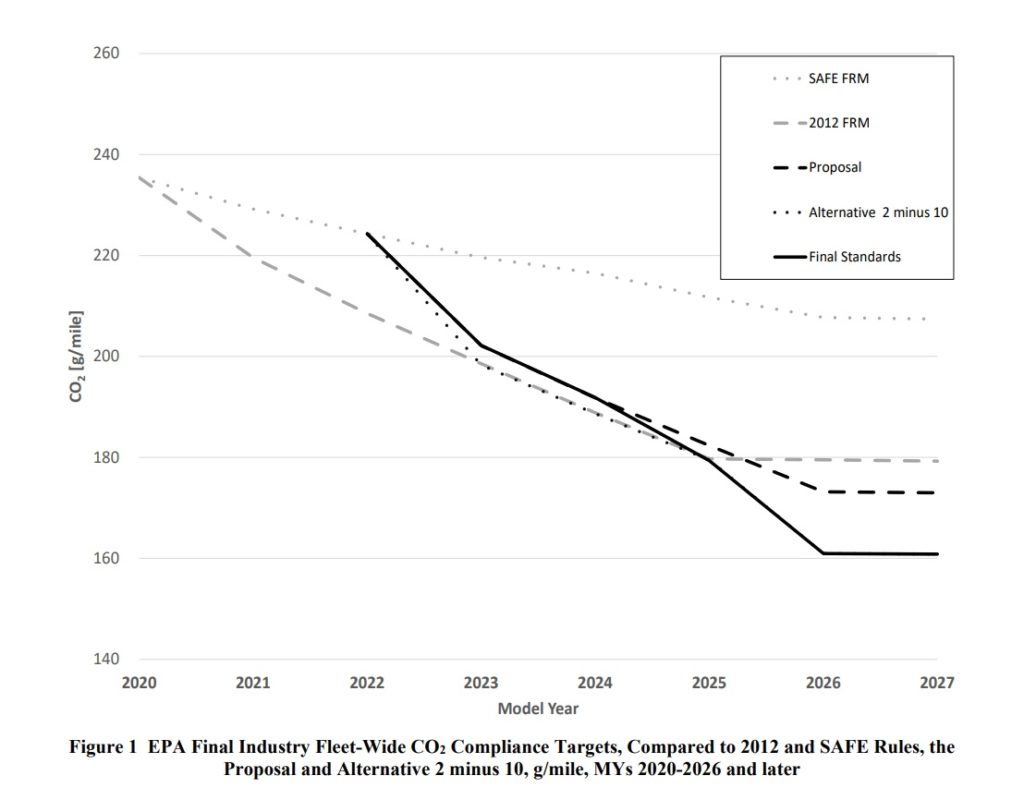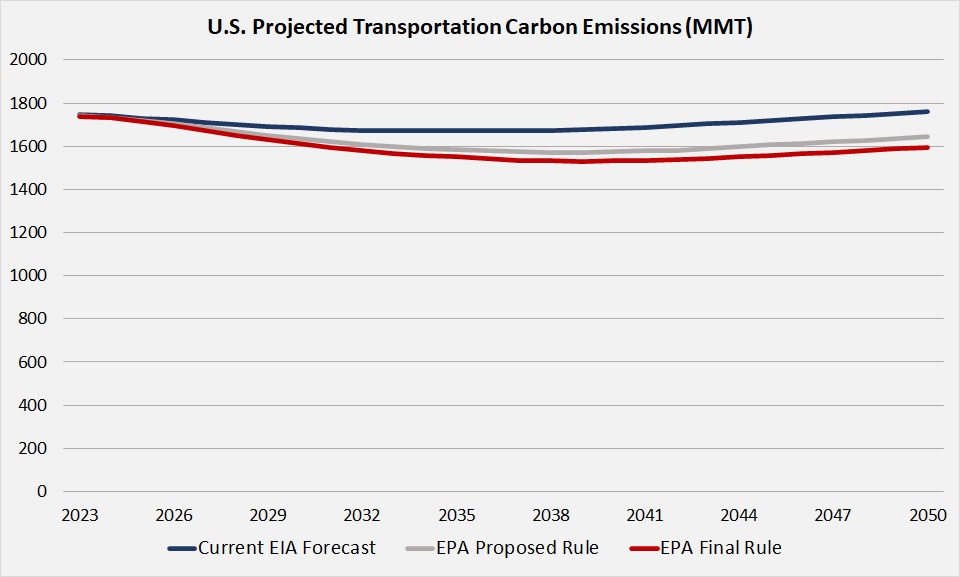Insight
December 20, 2021
Assessing the Climate Impacts of the EPA’s Final Vehicle Emissions Rule
Executive Summary
- The Environmental Protection Agency’s final rule on greenhouse gas emissions from light-duty vehicles is the first of several expected rulemakings targeting the transportation sector in an effort to help the United States meet its goal of reducing nationwide emissions 50 percent from 2005 levels by 2030.
- The final rule is projected to result in only modest emissions reductions despite going beyond the requirements adopted by the Obama Administration nearly a decade ago.
- With a total estimated cost of $180 billion, the rule is the most expensive final rule tracked by the American Action Forum since 2005.
Introduction
The Environmental Protection Agency (EPA) announced the Biden Administration’s first final rule aimed at reducing greenhouse gas emissions from the transportation sector. The rule, “Revised 2023 and Later Model Year Light-Duty Vehicle Greenhouse Gas Emissions Standards,” goes beyond the proposed emissions requirements published in August and scraps the Trump Administration’s signature deregulatory action.
Despite increasing the stringency of the emissions reductions – and the economic cost – the final rule is still relatively modest in terms of its climate benefits, though it likely sets the stage for more substantial reductions beginning with model year (MY) 2027.
This analysis updates the American Action Forum’s (AAF) assessment of the proposed rule, and looks at how much the EPA projects the final rule will reduce greenhouse gas emissions in light of the Biden Administration’s pledge to cut nationwide emissions by 50 percent of 2005 levels by 2030.
Current Emissions and Standards
According to the EPA, greenhouse gases from transportation are the largest source of emissions by sector in the United States, accounting for 29 percent. Light-duty vehicles (LDVs) – passenger cars and light trucks – account for 58 percent of transportation-sector emissions. Accordingly, substantial reductions in emissions from LDVs are critical to achieve the 2030 emissions goal.
The previous emissions standards for LDVs were set in 2020 by the Trump Administration. Its “Safer Affordable Fuel-Efficient Vehicles Rule for Model Years 2021-2026 Passenger Cars and Light Trucks” (SAFE Rule) revised an Obama Administration rule by reducing the annual percentage of emissions improvements vehicle manufacturers needed to meet. The Trump Administration’s standards called for a 1.5 percent emissions reduction improvement per year starting with MY 2021 and going through MY 2026.
The Biden Administration proposed a rule that was closer to the Obama Administration’s targets. This final rule, however, goes further. Starting in MY 2023, manufacturers would need to achieve a 9.8 percent improvement that year, followed by 5.1 percent, 6.6 percent, and 10.3 percent from MYs 2024-2026 respectively. Of note, EPA’s proposed rule does not establish the miles-per-gallon standards that most consumers are familiar with – those standards, which will work in conjunction with EPA’s grams-of-carbon-dioxide-per-mile emissions standards, come from the Department of Transportation. The figure below, from EPA’s final rule, compares the Biden Administration’s version against its two predecessor rules and the Biden Administration proposal.
Projected Emissions Reductions
The EPA’s analysis projects greenhouse gas emissions reductions of 3,125 million metric tons (MMT) from the final rule, compared to a baseline of the Trump Administration’s SAFE Rule, from 2023-2050, about 40 percent more than proposed. While the reductions are notable (6 percent over that timeframe), considering what the Biden Administration will need to achieve to reach its 2030 goal, the final rule remains modest at best.
According to the most recent calculation by the EPA, the United States emitted more than 6,500 MMT of greenhouse gases in 2019, with about 1,900 MMT from transportation sources. The projected reductions from the final rule, therefore, are less than half of the annual nationwide total but spread over 28 years. A visual representation of the annual impact of the final rule demonstrates the modest effect. The graph below shows the effect the final rule’s projected reductions would have on the Energy Information Administration’s (EIA) expected transportation sector emissions until 2050, and also compares it to the proposed rule.
EPA estimates the cost of its proposed rule at $180 billion through 2050 – the most-expensive proposed rule in AAF’s Regulation Rodeo database. The agency projects net benefits of $120 billion once fuel consumption savings and global climate benefits are factored in. Still, the significant costs weighed against the relatively modest emissions reductions portend massive regulatory costs for subsequent rulemakings, as deeper emissions reductions will need to be achieved to reach the administration’s 2030 goal.
These future reductions will likely be driven by significant increases in the percentage of new vehicles that are fully electric. In comments to EPA on the proposed rule, auto manufacturers cautioned the agency against pushing for standards that incorporate too much electric vehicle make-up of the overall vehicle fleet than can realistically be supported by consumers’ willingness to purchase such vehicles, especially in the near term.
Conclusion
The EPA’s final rule on LDV GHG emissions will bring modest reductions compared to the current EIA projection, though it does go further than the proposed rule – and adds commensurate costs. These modest reductions at high costs help illustrate that using regulation to drive emissions reductions rather than market-based mechanisms are a very expensive way to make little impact.












